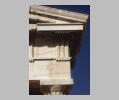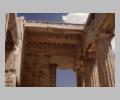| Context: | Athens |
| Type: | Gate |
| Summary: | Gate building; west end of the Acropolis. |
| Date: | ca. 437 BC - 432 BC |
| Dimensions: | Entire width: 48 m; central structure: 18 m x 25 m. |
| Region: | Attica |
| Period: | Classical |
Plan:
Central section of Propylaia: 2 parallel walls terminating in antae with Doric hexastyle prostyle porches; cross-wall, nearer the eastern than the western end, pierced by 5 doorways of 3 different widths. Central of the 5 doorways broadest; the other 4 are approached from the west by 5 steps. Double doors on each of the 5 doorways. Six Ionic columns, 3 on each side of the central ramped passageway. Northwestern wing: a rectangular chamber lined with stone dining couches. A door with windows on either side opened onto a Doric porch with 3 columns in antis. Southwestern wing: Doric porch with 3 columns in antis to match that of the northwestern wing, but no enclosed chamber behind. A free-standing double anta at the northwestern corner and a unique form of roof were employed to allow access to the Nike Sanctuary. The spaces between the central columns on the east and west fronts are so broad they require the unusual architectural detail of 2 triglyphs over the middle intercolumniations. Eastern pediment nearly 1.5 meters higher than the western due to rise in ground.
History:
Replaced an earlier structure known as the Archaic Propylon. Built by Mnesikles, construction was begun in 437 B.C. and completed in 432 B.C. Two great porticos flanking the Propylaia and fronting eastward were planned and commenced, but apparently abandoned: one, probably because it would have encroached upon the precinct of Artemis Brauronia; the other perhaps in consequence of the outbreak of the Peloponnesian War. The northwestern wing is often called the Pinakotheka by modern writers because paintings were displayed there. Portions of the main structure were unfinished, e.g. the rough bosses on the exposed surfaces of the marble blocks.
Other Bibliography:
See Also:





